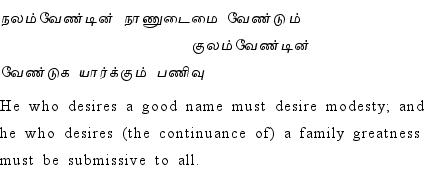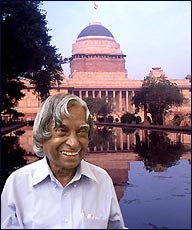

President Of India Address to the
STUDENTS, FACULTY AND STAFF OF INDIAN INSTITUTE OF SCIENCE
Bangalore, January 16, 2004

WHAT CAN I GIVE TO MY COUNTRY
I am indeed delighted to participate in the interaction meet with the students, faculty and staff of Indian Institute of Science. I greet the students and congratulate the faculty and staff members of IISc, for shaping the young minds. I have been associated with this campus for very many years. I always cherish interaction with the students and faculties in this intellectual environment. Here I am reminded the question asked by a young girl from Nagaland, during my visit. She asked me, Mr President, "can you tell me when will be able to live in a peaceful prosperous and safe India and how we as students could contribute effectively towards this mission? This is a very pertinent question for all of you. You have to ask yourself, "What I can give to our country?" My country has given me education, which is the highest possible education which any student can dream of". Keeping this in my mind, I have chosen the title of my talk, 'what can I give to my country'.
Righteousness
First of all, you must give it to yourself the best of education. You must be happy, you must be righteous, righteousness bring about beauty in character. You beauty in character brings peace at home; peace at home makes the nation prosperous. Prosperity of the nation will give peace to the people. Message of love and peace will lead to peace in the universe.
Creating a Nalanda
Now I would like to recall an incident, which happened during one of my visits after becoming the President. During my tour to the State of Bihar, among other programmes I visited various spiritual places, Bodh Gaya, and the famous Nalanda University. I walked through the monument and I saw a big hostel, a beautiful study hall of Buddhist philosophy and the college where teachers and students from nearly 63 countries used to study.
Why it happened in this country in the 5th century BC? Our civilisational heritage attracted students from various parts of the world. Dear friends, wherever I go young students ask me Mr. President why many of our scientists and engineers just after graduation move to foreign countries. What is the answer you have? The answer is we produce three hundred thousand engineers every year. India can afford to send some of them to work abroad. Due to our traditional family connectivity our professionals maintain the umbilical connection and bring back knowledge to our system. However, India has to have a full research and R&D lab to nurture our best of talents. Is it possible?. When I am in this campus, I feel that it is possible. A new Nalanda is possible here. That would be a great universal centre working in many parts of the world and throughout India. All of you have a great responsibility to achieve this mission.
Freedom movement and scientists
The fact that the Indian mind have always excelled over centuries was again shown when Ramanujam blossemed into the mathematical world. Similarly in the engineering field contribution of the towering personality like Shri Visveswarayya were remarkable. Some of the bear testimony even today, like Krishnaraja Sagar Dam and industries in Mysore. The freedom movement also created an urge in the Indian scientists to excel the scientists in the British empire. I believe the urge to show to the world the excellence of Indian minds would have been one of the major motivating factor of Sir CV Raman's major achievement. The same is the case with Prof Chandrasekhar. There are some interesting quotations from his biography, I quote from a book called "Chandra" by Shri Kameshwar Wali, "Chandra grew up in what was a golden age for science, art and literature in India, spurred on partly by the struggle for independence. J.C.Bose, C.V Raman, Meghnad Saha, Srinivasa Ramanujam, and Rabindranath Tagore, by their achievements in scientific and creative endeavours, became national heroes along with Jawaharlal Nehru, Mahatma Gandhi, and a host of others active in the political movement�. Did their success produce an enduring atmosphere for creativity, or did the prevailing cultural and social conditions hamper a healthy growth of sustained activity? Over the years, Chandra and I have discussed various facets of science in India and experiences of some of the eminent Indian scientists. The following excerpts reflect Chandra's thoughts on these matters."
"Chandra: I mean it is a remarkable thing that in the modern era before 1910, there were no (Indian) scientists of international reputation or standing. Between 1920 and 1925, we had suddenly five or six internationally well known men. I myself have associated this remarkable phenomenon with the need for self-expression, which became a dominant motive among the young during the national movement. It was a part of the national movement to assert oneself. India was a subject country, but in the sciences, in the arts, particularly in science, we could show the West in their own realm that we were equal to them."
Now, the country has a second vision, that is transforming India into a developed nation by the year 2020. I am sure, this challenging task will produce a number of internationally renowned scientists and technologists, as in the case of first vision, that was freedom movement. Let me briefly explain about five mega missions that simultaneous action for transforming India into a developed nation.
Five Mega Projects to transform the nation to Developed Country
We have identified five areas where India has a core competence for an integrated action. (1) Agriculture and food processing - we have to put a target of doubling the present production of food and agricultural products. Other areas of agriculture and agro food processing would bring prosperity to rural people and speed up the economic growth. (2) Reliable and quality electric power for all parts of the country. (3) Education and Healthcare (4) Information Technology - this is one of our core competence. We believe, this area can be used to promote education in remote areas and also to create national wealth. (5) Strategic sectors - fortunately, this area witnessed the growth in nuclear technology, space technology and defence technology.
These five areas are closely inter-related. A strong partnership among the R&D, academy, industry and the community as a whole with the Government departments will be essential to accomplish the vision. I would like to highlight two important missions which provide large opportunity and challenge, particularly to the youth in realizing our dream.
Networking of rivers
Networking of rivers is essential for flood and drought control, for availability of drinking water to all regions, for goods navigation and transportation and for increased power generation and cultivation land. This mission will also provide employment opportunities to the rural population. Science and technology can surely help in executing such mission. Remote sensing to survey and evolve optimum water routes, environmental mapping and afforestation requirements, and continuous monitoring of the networked water flow through all seasons and at all times may require a dedicated satellite constellation for our networked river systems. Above all, the networking will lead to enhancement of environment and national connectivity.
Knowledge powered PURA (Providing Urban amenities in Rural Areas)
Providing Urban amenities in Rural Areas (PURA) is another example for creating rural wealth and prosperity. The model envisages a habitat designed to improve the quality of life in rural places and makes special suggestions to remove urban congestion also. Naturally our most demanding urban problem is that of congestion removal and efficient supply of water and effective waste disposal in every locality are the paramount civic needs. There is a minimum size below which a habitat is not viable and not competitive with the existing congested city. At the same time, the existing congested city is not economical compared to a new town once a minimum size of expansion is crossed. As against a conventional city say, rectangular in shape and measuring approximately 10 km by 6 km, the model considers an annular ring-shaped town integrating minimum 8 to 10 villages of the same 60 km2 area. This model provides easy access to villages, saves transportation time and cuts costs substantially and is more convenient for general public. Knowledge powered rural development is an essential need for transforming India into a knowledge power and high bandwidth rural connectivity is the minimum requirement to take education, health care and economic activities to the rural areas. Knowledge society leading to knowledge super power can prosper and survive only in the environment of economic security and internal security. Physical connectivity by providing roads, electronic connectivity by providing reliable communication network and knowledge connectivity by establishing professional institutions and vocational training centers will have to be done in an integrated way so that economic connectivity will emanate. Such Model of establishing a circular connectivity among the rural village complexes will accelerate rural development process by empowerment.
Research Focus
As an institution advanced learning in science and engineering, there is a need to give greater thrust to research. This will require creation of state of the art research laboratories. I would suggest a tripartite research center with Government academia and industry participation be established which could undertake research on problems with four or five year gestation period and long-term exploratory fundamental research. Also the research community should think of starting research during their teens when the minds are highly creative and innovative.
Entrepreneurial leadership
When you go out of this campus you should have the confidence to start an enterprise individually or jointly. Entrepreneurship development should become a part of your curriculum. Recent experiences in some of the developed country indicate that large number of small entrepreneurs employing less than 50 persons in their establishments make significant contribution to the economic progress of a nation. We need such entrepreneurs in large numbers in our country for developing and transforming our village clusters into sustainable economic units which I call as "PURA Enterprise". The entrepreneurial leadership has three parts. First, problem finding and problem solving in the context of development. In second part, the entrepreneurs should have the willingness to take risk and be bold to do things differently. You must learn to take calculated risks for the sake of larger gain. The third part is the disposition to do things right.
Conclusion : what can I give to my country?
Every one of us has gone through the various phases of education from childhood to profession. A scene appears in front of me. A child, a teenager, an adult and a leader. How does each one react to a particular situation? The situation is human need. The child asks, "What can you do for me"? The teenager says, "I want to do it alone". The young person proclaims, "let us do it together". The leader offers, "What can I do for you". IISc is transforming you to become a leader. I am sure, with this spirit you will always ask yourself a question what can I give to my country and be a partner in transforming the nation into a peaceful, prosperous and happy place to live.
My best wishes to all of you, Dr. A.P.J. Abdul Kalam.
Source: www.presidentofindia.nic.in| Go Back | Go Top | Go Home |